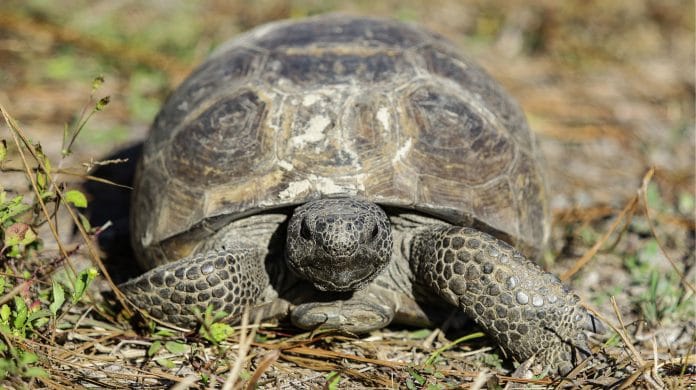During this hardship we all are enduring, there is one similarity we now have with the gopher tortoise, and that is they spend most of their time in their burrows. Let us take this time to appreciate one reptile that is a valued species for our ecosystems and an animal we can, in a way, relate too.
Fun facts:
- Commensal Species- other wildlife species use their burrows
- State-designated Threatened
- Dig with their front feet
- Gopher Tortoises do sneeze
- They live alone and spend 80% of their time in their burrows
- Their burrow can be up to 40 feet in length and 10 feet deep
- Females a clutch of 6-9 eggs
- Baby tortoise uses a unique tooth (egg tooth) to break out of their shell
What is so important about a tortoise? Well, they are important because of their home. The gopher tortoise is a keystone species.
A keystone species are species that play a critical role in the ecosystem. If that species, such as the gopher tortoise, were to be removed, the ecosystem would drastically change.
Its home, the burrow, plays a vital role for up to 360 species; like the eastern indigo snake, pine snakes, burrowing owls, Florida mice, foxes, quail, gopher frogs and many more.
Habitats in which the need are sandy soils, like sandhills, scrub, dunes and scrub flatwoods. That sandy soil enables them to dig their burrows. Their burrow can reach up to 40 feet in length and 10 feet deep.
“Central Florida is the core of this really, really extremely unique biodiverse ecosystem and it’s also the region where everyone is moving to and developing right now,” said Dr. Jeff Goessling, Chair for the Research Advisory Committee for The Gopher Tortoise Council and conservation ecologist and Assistant Professor at Eckerd College.
Goessling stated Central Florida faces the most intense developmental pressure in North America. With rising sea levels, people are moving to high and dry areas in Florida because those areas are not susceptible to flooding.
“From a conservation standpoint, the loss of these large tracts of habitat that have tortoise is a direct threat to the one most biodiverse (area) on earth that took several million years in the making that can be gone in a matter of decades,” said Goessling.
Boyd Hill Preserve, for example, located in Saint Petersburg, is a prime location for Goessling and his students to manage a long term study on gopher tortoise survival. His research covers everything from collecting blood samples to measurement as well as other imperative information.
Goessling explained that Boyd Hill has a following of community members, and people are continuously putting pressure on the city, but at the same time there’s a really strong defense against that which is the people who care about conserving the population of this animal who is unique with a vital landscape. Without education, without understanding, without outreach, there wouldn’t be a grassroots interest in conserving it (land), and over time these preserves wouldn’t last or wouldn’t exist. It is only for the work of those people 50 years ago who had the foresight to set this land aside.
“It’s the work we do today that will guarantee it (land) will be around in 50 years from now,” Goessling said.
In light of all we are enduring and how unreal it seems, learning about the wildlife around you can help you form some type of understanding of why Florida is so unique and how there are many ways we, as humans, can help preserve their habitat.
The Gopher Tortoise Council was formed in 1978 by a group of southeastern biologists and other citizens concerned with the decline of the gopher tortoise. The goals of the Council are: (1) to offer professional advice for management, conservation, and protection of gopher tortoises; (2) to encourage the study of the life history, ecology, behavior, physiology, and management of gopher tortoises and other upland species; (3) to conduct active public information and conservation education programs; (4) to seek effective protection of the gopher tortoise and other upland species throughout the southeastern United States. [http://gophertortoisecouncil.org/]
The strength in a community can go a long way, and how you, your family, friends, school, organization, or business can get involved is to learn more about Gopher Tortoise Day at http://gophertortoisedayfl.com/.
Florida Fish and Wildlife Conservation Commission has great tools and fun projects to learn more about the gopher tortoise: https://myfwc.com/education/wildlife/gopher-tortoise/
(Interview with Dr. Jeff Goessling conducted in April 2019.)

